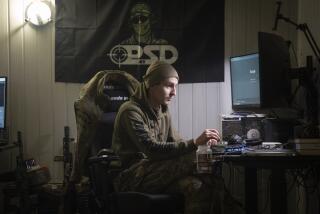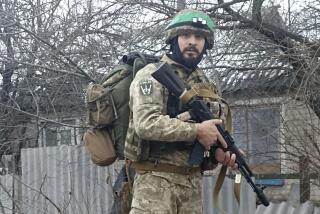Kosovo’s Rebels Are Armed and Ready
- Share via
LIKOVC, Yugoslavia — The guerrilla commander roared up in a blue Ford station wagon. Fitted with shiny Kalashnikov automatic rifles, walkie-talkies and camouflage, the commander and his men appeared ill at ease. New clashes with Serbian police were erupting to the west. Yugoslav warplanes crossed the sky above. The previous nights brought regular gunfire.
“Every day we expect an attack,” said the bearded commander from the Kosovo Liberation Army, a clandestine band of ethnic Albanian separatists fighting for the Albanian-majority province’s independence from Serbia.
The guerrillas appeared Tuesday to be in control of several hilltop villages in the rebellious Drenica region of Kosovo, site earlier this month of a fierce police crackdown that claimed at least 80 Albanian lives.
But renewed police attacks on other villages and rebel ambushes of police--with at least five people reported killed--were threatening to escalate the conflict here once again, on the eve of a critical meeting of world powers in Bonn.
That meeting today of the six-nation Contact Group, chaired by the United States, is to consider punishing the Yugoslav government for its repression of the country’s ethnic Albanian community.
In the hills of Kosovo, the rebels do not put much stock in international summits. “Traitors” is how the bearded commander sees the Contact Group.
“We are not afraid,” said the commander, a slight man in his late 20s wearing black fatigues, a military vest and a pistol on his hip. “We will resist if we have to fight like Prekaz.”
The village of Prekaz was home to a reputed Kosovo Liberation Army leader who was killed, along with much of his family, in the police operation.
Years of frustration over Serbian rule in Kosovo collided with this month’s killings to swell the ranks of men eager to take up guns against the government. The Kosovo Liberation Army is not thought to have more than a few hundred fighters but appears to be building successfully on a foundation of peasant militias that have operated in the region for decades.
Guerrillas met with three American reporters in this isolated village about 25 miles west of the provincial capital, Pristina. The village is reached only over a steep, rutted back road, barely more than a goat path in some spots, through forests of scrub oak. Other roads were blocked by either police checkpoints or barricades of logs and boulders laid by rebels or their sympathizers.
“This is the center,” said a local resident who supports the rebels. “Serb forces can only come by the skies and tanks and only with blood. . . . People are ready to die for freedom. We cannot be slaves.”
With two of his men, the bearded commander entered a rundown roadside cafe where the journalists were waiting. He ordered the place cleared “so I can talk to these people.” About 25 men filed out quietly. After reviewing the journalists’ identification papers, the commander insisted on examining their sunglasses. He suspected hidden cameras, he said. He was clearly not happy to have visitors.
One of his companions, a man in his 40s, wore a new green-and-red camouflage uniform and carried two Kalashnikovs slung across his back and chest. He and other uniformed rebels seen Tuesday wore arm patches with the Albanian national symbol of a black eagle on a red background.
The commander spoke Albanian with an accent typical of this remote Kosovo region but appeared to have had formal education. He offered contradictory views about the role of outsiders, especially the press, in this conflict: At one moment he chastised journalists for shirking their duty by not risking their lives sufficiently to cover Kosovo--then in the next breath he labeled foreign and local journalists Serbian spies who cannot be trusted.
The rebels and villagers described a kind of standoff between guerrillas and police special forces occupying positions several miles away from the hilltop villages. The two sides have been exchanging harassment fire sporadically over the past several days. Although the police did not seem to be gaining ground, neither had they pulled back as Western governments have demanded.
As fighting flared again Tuesday elsewhere in the Drenica region, there were reports that the Yugoslav government was deploying well-armed reinforcements. In Bonn, Secretary of State Madeleine Albright said Serbian police were “digging in”--a sign that Yugoslav President Slobodan Milosevic continues to flout Western demands for moderation.
Serbian and Albanian sources said clashes between police and Albanians lasted several hours Tuesday afternoon in three villages around the town of Decani, about 45 miles west of Pristina. Ethnic Albanian political officials said several houses were on fire, scores of people were fleeing, and at least four people were killed.
The Serbian government said Albanian “terrorists” opened fire on police checkpoints, killing one officer and wounding a second.
Journalists trying to investigate the reports also came under mortar and automatic-weapon fire.
The Kosovo Liberation Army first gained prominence in February 1996, claiming responsibility for attacks on Serbian refugee camps, and for the most part limited its activities to hit-and-run killings of Serbian police and Albanian collaborators.
Last November, however, it launched coordinated attacks on police stations that showed a greater level of organization.
Ethnic Albanian sources familiar with the militant group say many of its commanders were trained in the old Yugoslav National Army and then purged in 1990-91, after Milosevic revoked Kosovo’s autonomy and many ethnic Albanians were removed from state institutions.
Younger rebels have not received that training, however, because most of Kosovo’s Albanians have refused obligatory military service since autonomy was lost.
A large and affluent diaspora is believed to be financing, equipping and helping to organize the rebels.
In Tuesday’s encounter with the Kosovo Liberation Army, the guerrillas refused to answer many questions in detail. The commander told the reporters that they should concentrate their reporting on the dire plight of women and children driven from their villages by the violence. He would not permit interviews with other rebels, and no women or children were visible.
The guerrillas then ordered the reporters to leave under their armed escort. The commander boarded his blue station wagon, which displayed a Swiss registration, no license plates and a “Baby on Board” bumper sticker. Barking into his walkie-talkie, he led the reporters down another dirt road.
Along the way, peasants on tractors, herding scrawny cows, waved. The entourage passed by two guerrilla sentry posts several miles apart, the last manned by three armed men, one in uniform. There the guerrilla escorts peeled off.
Another mile down the hill, little children with book bags walked home from school.
More to Read
Sign up for Essential California
The most important California stories and recommendations in your inbox every morning.
You may occasionally receive promotional content from the Los Angeles Times.














